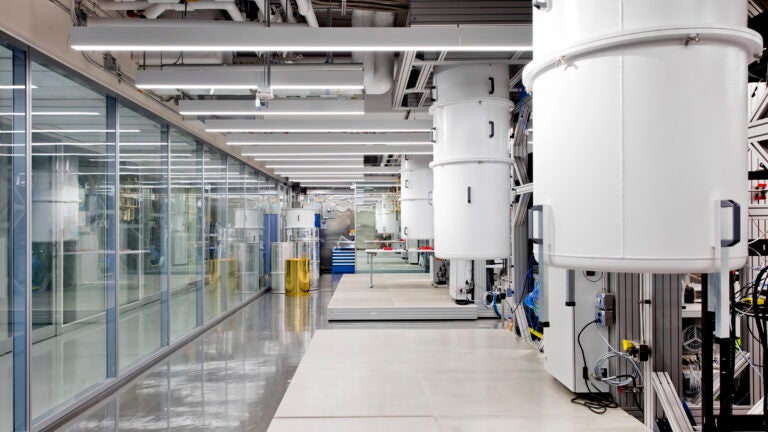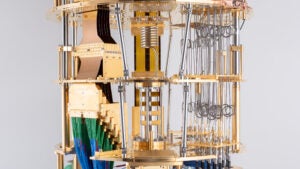
The powerful computational system of IBM’s quantum computers could help manage complex calculations that may soon be too difficult for computers that use traditional silicon processors. (Photo/Connie Zhou for IBM)
IBM agreement boosts USC’s quantum computing leadership
The collaboration with IBM — part of USC President Carol Folt’s Frontiers of Computing “moonshot” — establishes USC’s IBM Quantum Innovation Center and propels USC researchers and students toward new discoveries.
USC has a new agreement with IBM that boosts quantum research by scientists and students and will reinforce the university’s status as a leader in quantum research and a top trainer of the nation’s tech workforce.
“Our new partnership with IBM to expand quantum computing at USC will boost research and innovation in this field and marks a major milestone for our Frontiers of Computing initiative,” USC President Carol Folt said. “By opening the first IBM Quantum Innovation Center on the West Coast, USC is inviting top researchers and game-changers in industry to join us in shaping the future of quantum computing.”
The agreement also accelerates the university’s efforts to achieve the research and education objectives of Folt’s Frontiers of Computing “moonshot,” a more than $1 billion initiative that supports ethical advancement in areas such as artificial intelligence, robotics and quantum computing.
USC started official operations as an IBM Quantum Innovation Center on Feb. 1, giving the university’s researchers cloud access to IBM quantum systems.

“We are excited to collaborate with USC, not only to help advance their research interests, but to prepare their students to join a rapidly growing quantum workforce,” said Jay Gambetta, IBM Fellow and vice president, IBM Quantum. “And with increasing industry interest, USC will play an important connector role as an IBM Quantum Innovation Center, providing a path for organizations to jointly develop algorithms and use cases for practical applications of quantum computing.”
Across the USC Viterbi School of Engineering and the USC Dornsife College of Letters, Arts and Sciences, researchers note that the collaboration greatly increases USC’s quantum capabilities for research. The powerful computational system of IBM’s quantum computers could help them manage complex calculations that may soon be too difficult for ordinary, “classical” computers that use traditional silicon processors.
“The new IBM Quantum Innovation Center at USC will be a pillar in our ability to do cutting-edge research in the area of quantum computing and to train future scientists who will be making exciting discoveries,” said Daniel Lidar, the director of the USC Center for Quantum Information Science and Technology who will also direct USC’s IBM Quantum Innovation Center.
Until recently, USC had been using IBM’s open access plan.
“Anyone in the world can run experiments via the cloud using a limited set of IBM’s quantum computers,” said Lidar, a professor of multiple disciplines — electrical and computer engineering, chemistry, physics and astronomy at USC Viterbi and USC Dornsife, and the holder of the Viterbi Professorship. “Now, thanks to the IBM Quantum Innovation Center, we can run our experiments on a wider array of the cutting-edge quantum computers that IBM makes available.
 The partnership is another plus in USC’s favor for students aspiring to enter the field of quantum information science and for Big Tech companies, government contractors and agencies that are recruiting for the specialty. Several dozen students enrolled in the USC Dornsife and USC Viterbi master’s program this academic year have been given immediate access to the IBM quantum machines.
The partnership is another plus in USC’s favor for students aspiring to enter the field of quantum information science and for Big Tech companies, government contractors and agencies that are recruiting for the specialty. Several dozen students enrolled in the USC Dornsife and USC Viterbi master’s program this academic year have been given immediate access to the IBM quantum machines.
“The remarkable innovation that underpins quantum computing is the result of decades of knowledge exchange between industry leaders like IBM and academic researchers at universities like USC,” USC Dornsife Dean Amber Miller said. “Building on this long tradition of collaboration, we will work together to accelerate the quantum revolution and deepen our fundamental understanding of the world.”
Quantum computing shows promise as a revolutionary technology because, in theory, its processing speeds far exceed those of classical computers, particularly in solving especially difficult computational problems. Although the technology has not yet crossed the threshold where it demonstrates an overwhelming advantage, many scientists think that day will soon come.
“The quantum realm is an exciting and intriguing next frontier in computing, communications and sensing. USC has anticipated this emergence and has been at its forefront for more than a decade with the assembly of a strong group of faculty who advanced academic quantum computing and communications both on campus and at our own Information Sciences Institute,” said Yannis C. Yortsos, dean of USC Viterbi.
“Today, we are taking another significant step with the partnership with IBM Quantum,” Yortsos added. “It will further catalyze our pioneering research in leveraging quantum phenomena for technology and in educating the next generation of engineering and science students in the fascinating quantum world.”
Quantum computing: A new era of research and innovation
When it happens, the development of applications with a quantum advantage could affect multiple industries. With quantum computing, scientists expect to achieve potential breakthroughs in drug discovery, energy-efficient electronics and energy storage. Quantum also may be the key to breakthrough advancements in machine learning that could address issues in areas such as sustainability and image processing.
“With the proliferation of artificial intelligence and machine learning problems, and the need to assemble training data for those areas, we are going to have to deal with larger and larger datasets,” said Mahta Moghaddam, vice dean of research for USC Viterbi and a Distinguished Professor of electrical and computer engineering.
“Current computers are going to have limitations as the size and diversity of datasets grow, so eventually we are going to need the quantum solutions to make those AI problems solvable,” said Moghaddam, who holds the Ming Hsieh Chair in Electrical and Computer Engineering-Electrophysics.
The IBM agreement is the latest milestone for the university in its quantum journey. The university is already a proven leader in quantum, ranked among the top five programs in quantum information systems, as reported by The Quantum Insider, with particular strength in quantum computing, quantum cryptography and quantum information theory. Its other strength is quantum error correction, an essential aspect in the quest to enable quantum computers to realize their computational advantage despite their susceptibility to errors due to external disturbances.
“This agreement reinforces USC’s leadership in quantum information science,” said Moh El-Naggar, the USC Dornsife divisional dean of the physical sciences and mathematics who helped facilitate the agreement. “Our faculty experts were ahead of their time in applying emerging quantum computers to address grand challenges in health and energy. We strategically designed this agreement to now position USC as a hub for future industry partnerships that benefit from our expertise and prioritized access to quantum hardware.”
Some scientists believe it is not long — perhaps less than 10 years — before quantum computers are used to solve some computational problems that are unsolvable for CPUs or GPUs. Last summer, IBM reported a crucial breakthrough in a Nature paper, demonstrating the ability of today’s quantum systems to operate at utility scale — the point at which quantum computers can serve as scientific tools to explore new classes of problems beyond brute-force, classical simulation of quantum mechanics.
“The universality of the IBM quantum systems means that they are designed to support running any calculation — just like you can on an ordinary laptop or desktop — of course, with added quantum power,” Lidar said. “For example, last year, a former student (now at IBM) and I reported the first example of an algorithmic quantum speedup: We used IBM’s quantum computers to solve a guessing problem faster than is possible using any classical computer.”
When quantum computers surpass classic computers in the ability to solve certain complex problems, this may be accompanied not just by revolutionary computational speedups, but also by massive reductions in energy consumption, Lidar said.
“Once you cool everything down, the computation expends little energy, and that is very different from the way that ordinary classical computers operate,” said Lidar, who envisions a solution soon. “Combining this with quantum speedup means that a large-scale quantum computer will eventually consume far less energy than a classical supercomputer.”
Tomorrow’s tech jobs will be in quantum computing
The IBM agreement provides USC with access to tools to conduct advanced research and train students at the vanguard of computing advancement and research. “Access to IBM’s quantum systems invigorates the work of 20 or so faculty across USC Dornsife and USC Viterbi,” said Stephen Bradforth, USC Dornsife Dean Miller’s senior advisor for research strategy and development.
The new quantum center at USC also includes opportunities for jobs and innovations, as well as new business opportunities for students who graduate from the university, particularly in STEM.
“This resource positions our doctoral students and postdocs in math, physics, chemistry and computational biology at the leading edge in designing algorithms to tackle hard computational problems in each of these disciplines in totally new ways,” Bradforth said.
More employers, including government agencies, are seeking graduates with quantum science and technology degrees in both the public and private sectors, and the matter of educating and training the quantum workforce is a concern highlighted in recent federal reports. The White House and National Quantum Initiative in 2022 mapped a path to building a quantum workforce, and the federal government continues to seek input from research and higher education industries to create a pipeline that can meet the rising national need for quantum.
Quantum technology is valued in the billions of dollars and its potential is even greater. A report by McKinsey & Co. last April noted that annual quantum technology startup investments hit $2.35 billion before it issued the report. The company then estimated that the quantum technology sector could reach $106 billion in value by 2040.
With foresight in 2020, USC spearheaded the launch of a master’s program in quantum information systems. Two cohorts have graduated and landed jobs at tech giants, including Amazon, Google and, of course, IBM. USC graduate students and postdocs also have landed research positions at national laboratories and faculty positions at Duke University, Cornell University and the University of New Mexico, as well as many other universities worldwide.
“Students who graduate from our programs tend to do very well in terms of being placed in either industry or academia,” Lidar said.
USC Dornsife and USC Viterbi leaders expect even more interest in quantum coursework and scholarship now that the university is an IBM Quantum Innovation Center. And they are ready for a new wave of students and research.



